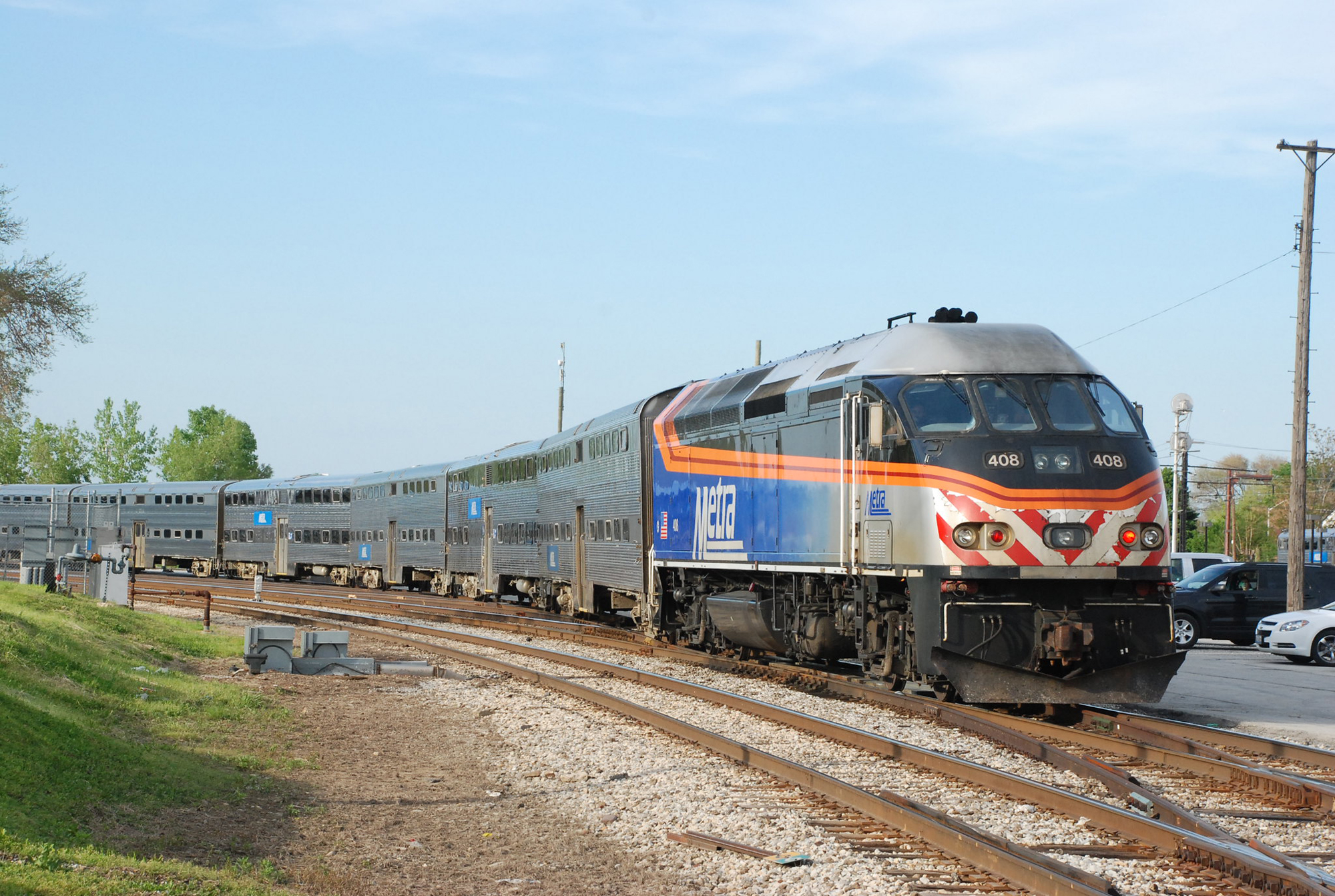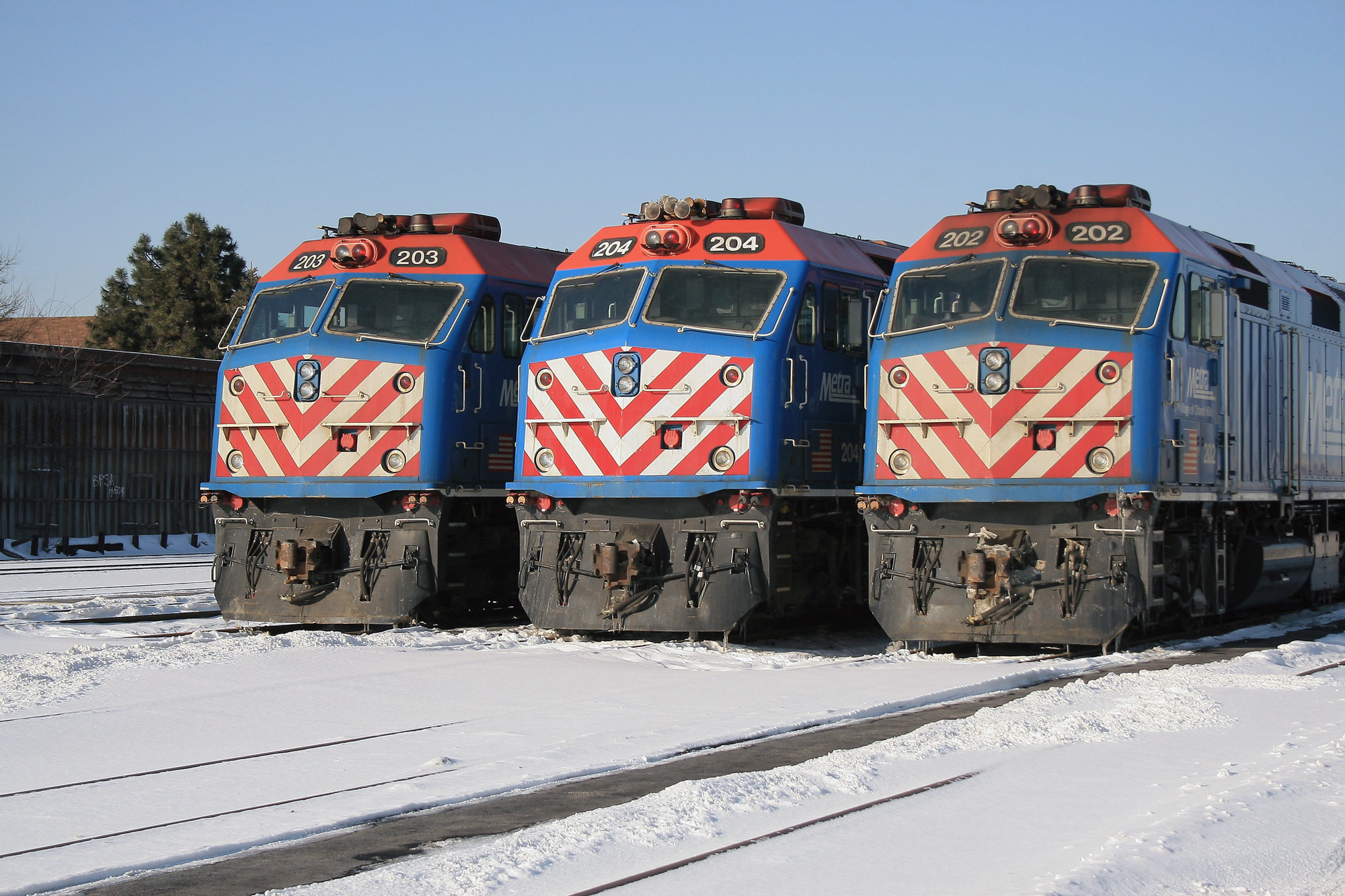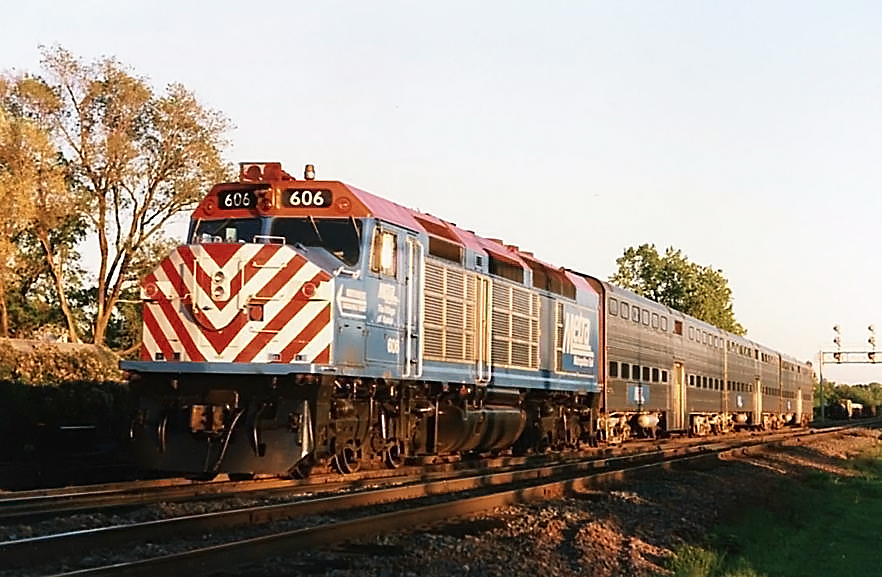- Home ›
- Commuter Rail ›
- Metra
Metra, Chicago's Commuter Rail System: A Brief Guide
Last revised: September 6, 2024
By: Adam Burns
Metra is the commuter rail system serving the Chicago metropolitan area, a lifeline for tens of thousands of residents and visitors navigating this bustling metropolis.
With 11 lines extending into the suburbs and beyond, understanding Metra's extensive network can significantly enhance your travel experience in Chicago.
Currently, the system - in operation sincer 1984 - maintains 488 route miles with 1,155 miles of track, 800 bridges, and 2,000 signals. Metra serves six counties, including Cook, DuPage, Will, Lake, Kane, and McHenry, and covers more than 3,700 square miles.
This guide will provide an overview of the system's history, present-day operations, and practical tips for travelers.
 Metra MP36PH-3S #408 is pushing a commuter train eastbound at Blue Island, Illinois on May 22, 2014. Doug Kroll photo.
Metra MP36PH-3S #408 is pushing a commuter train eastbound at Blue Island, Illinois on May 22, 2014. Doug Kroll photo.Early Beginnings: The Foundations of Commuter Rail in Chicago
The roots of Chicago's commuter rail system can be traced back to the mid-19th century. By the 1840s, the city was becoming a significant railroad hub, with lines like the Galena and Chicago Union Railroad offering services that hinted at what would become the modern commuter rail. These early railroads were critical in facilitating the city's expansion, integrating suburban areas into the city's economic and social fabric.
Evolution of Services: 1900s-1970s
From the late 19th century into the mid-20th century, numerous private railroad companies operated commuter services.
These included the Chicago, Burlington & Quincy Railroad (CB&Q); Chicago and North Western Railway (C&NW); Illinois Central Railroad (IC); and Chicago, Rock Island and Pacific (Rock Island) among others. As automotive travel rose in popularity from the 1950s onwards, passenger volumes declined, leading to financial difficulties for private rail operators.
Formation
By the late 1970s, it was clear that a coordinated regional approach was necessary to preserve and enhance commuter rail services.
In 1984, the Regional Transportation Authority (RTA) created the Northeast Illinois Regional Commuter Railroad Corporation, commonly known as Metra. The new organization assumed control of several ailing services, restructuring them to improve efficiency and reliability.
Present Day Operations
Overview of the Network
Today, Metra operates 11 lines, radiating from downtown Chicago to its suburbs, covering over 488 route miles with nearly 242 stations. The lines include:
1. **BNSF Railway Line**
2. **Heritage Corridor Line**
3. **Metra Electric District**
4. **Milwaukee District North and West Lines**
5. **North Central Service**
6. **Rock Island District**
7. **SouthWest Service**
8. **Union Pacific North, Northwest, and West Lines**
 A trio of Metra's classic F40PHM-2s, #202-#204 are lined up at Blue Island, Illinois on January 18, 2009. Doug Kroll photo.
A trio of Metra's classic F40PHM-2s, #202-#204 are lined up at Blue Island, Illinois on January 18, 2009. Doug Kroll photo.Key Stations
Metra's system converges in downtown Chicago at four major stations:
- **Union Station:** Serving BNSF, Heritage Corridor, Milwaukee District, North Central Service, and SouthWest Service lines.
- **Ogilvie Transportation Center:** Terminal for Union Pacific North, Northwest, and West lines. This station is located on the former site of Northwestern Terminal, Chicago & North Western's primary Chicago passenger hub.
- **LaSalle Street Station:** Serving the Rock Island District.
- **Millennium Station:** The hub for the Metra Electric District line.
##### Ticketing and Fares
Metra offers a range of ticket options to suit different travel needs:
- **One-Way Tickets:** Ideal for occasional travelers.
- **Ten-Ride Tickets:** Offering a discount over the cost of ten single rides.
- **Monthly Passes:** Best for daily commuters, providing unlimited travel for a calendar month.
- **Weekend Passes:** Offering unlimited travel over a weekend for a flat rate.
Tickets can be purchased at station ticket counters, vending machines, or through the Ventra app, which also supports digital ticketing and schedule information.
##### Service Schedules
Metra trains operate on a well-structured timetable. Peak service usually corresponds with morning and evening rush hours, with reduced frequency during off-peak times and weekends. It is advisable to check the up-to-date schedules available on Metra's website or the Ventra app, especially if traveling during holidays or special events.
Navigating the Metra System: Practical Tips for Travelers
1. **Planning Your Trip:**
- Determine your starting station and destination.
- Obtain a timetable for your line to select convenient train times.
- Plan to arrive at the station at least 10 minutes before departure.
2. **Purchasing Tickets:**
- Use the Ventra app for a seamless ticket-buying experience or purchase tickets at station vending machines or ticket counters.
- Ensure you have a valid ticket before boarding the train.
3. **Boarding and Riding:**
- Note the train’s destination displayed on platform monitors or listen for announcements.
- Board the appropriate train car, paying attention to any designations for quiet cars or bike cars.
- Keep your ticket handy as conductors will check for fare compliance during your journey.
4. **Transfers and Connections:**
- Some lines require a transfer at a central hub like Union Station.
- Allow extra time for transfers and consult Metra personnel for assistance if needed.
5. **Accessibility:**
- All Metra stations and trains are ADA compliant.
- Elevators, ramps, and designated seating areas are available for passengers with disabilities.
6. **Bicycles:**
- Bikes are welcome on all Metra trains, but certain restrictions apply during peak hours.
- Designated bike cars are available on select lines.
7. **Safety and Etiquette:**
- Observe onboard rules, such as keeping noise to a minimum in quiet cars.
- Stand clear of the platform edge while waiting for your train.
- In case of emergencies, note the location of train crew or transit police.
At A Glance
From Metra.com:
- Route Length: 488 miles
- Track Length: 1,155 miles
- Parking Spaces: 90,483
- 54% of Metra riders drive while 26% walk or bike to their boarding station
- 2% more people live and work in the Metra service area than did in 2010
- System ridership decreased 10% over the past 10 years
- Annual Estimated Passenger Trips (2019): 74.0 million
- Average Trip Length (2019) : 22.3 miles
- Average Fare Paid (2019) : $4.99
- Number of Weekday Trains (Dec 2019): 692
- Number of Saturday Trains (Dec 2019): 273
- Number of Sunday Trains (Dec 2019): 181
- On-Time Performance (2019): 94.6%
- Number of Stations: 242
 Metra F40C #606 is on the Milwaukee District North line at Libertyville, Illinois on May 27, 1989. Doug Kroll photo.
Metra F40C #606 is on the Milwaukee District North line at Libertyville, Illinois on May 27, 1989. Doug Kroll photo.Conclusion
With over a century of heritage and continuous adaptation, the Metra commuter rail system stands as a vital component of Chicago’s transportation network. Its extensive reach, reliable service, and various ticket options make it an indispensable means of travel for both residents and visitors.
By understanding its routes, fare systems, and operational nuances, travelers can navigate the Metra system with ease, making the most of their time in Chicago and its surrounding areas.
Whether commuting daily or exploring the rich cultural and historical tapestry of the Chicago metropolitan area, Metra offers a journey that is both convenient and enriching.
Recent Articles
-
Ferrocarriles Nacionales de México (N de M)
Jan 04, 26 11:52 PM
For much of the twentieth century, Ferrocarriles Nacionales de México—better known by its classic initials N de M, and later as FNM/Ferronales—served the heart of Mexico. -
Missouri Dinner Train Rides In Branson!
Jan 04, 26 07:00 PM
Nestled in the heart of the Ozarks, the Branson Scenic Railway offers one of the most distinctive rail experiences in the Midwest—pairing classic passenger railroading with sweeping mountain scenery a… -
Indiana Dinner Train Rides In Jasper
Jan 04, 26 06:32 PM
In the rolling hills of southern Indiana, the Spirit of Jasper offers one of those rare attractions that feels equal parts throwback and treat-yourself night out: a classic excursion train paired with…



